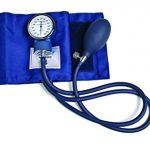 Instrument for measuring blood pressure.
Instrument for measuring blood pressure.
An instrument used for measuring arterial blood pressure.
Medical instrument used to measure blood pressure; it consists of an inflatable cuff connected by a rubber tube to a column of mercury with a graduated scale for both systolic and diastolic pressure.
An instrument used to measure blood pressure in the arteries. A sphygmomanometer allows a doctor or nurse to determine both the systolic and diastolic pressures in an artery. The average blood pressure measurement for a healthy adult is 120/80 millimeters of mercury.
An instrument for measuring blood pressure in the arteries. It consists of an inflatable cuff connected via a rubber tube to a column of mercury with a graduated scale. The cuff is applied to a limb (usually the arm) and inflated to exert pressure on a large artery until the blood flow stops. The pressure is then slowly released and, with the aid of a stethoscope to listen to the pulse, it is possible to determine both the systolic and diastolic pressures (which can be read on the scale).
The traditional device for measuring blood pressure. It relies on an inflation-deflation system, an occluding bladder encased in a cuff, and a digital recording. Older intruments rely on a mercury column, and the use of auscultation with a stethoscope, but these have been phased out for safety reasons.
An instrument for determining arterial blood pressure indirectly. The two types are aneroid and mercury.
A tool utilized to gauge blood pressure. The device includes a cuff affixed to it, which is secured around an individual’s arm and then inflated to apply pressure on the primary artery. Subsequently, the cuff is gradually deflated as the user employs a stethoscope to listen to the blood flow. Depending on the specific device employed, the blood pressure reading can be observed on a graduated glass column filled with mercury, a graduated dial, or a digital screen.
A device for gauging arterial blood pressure.
